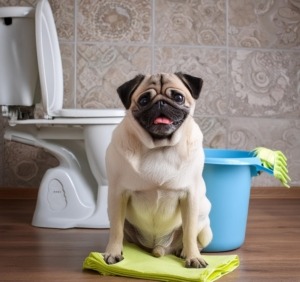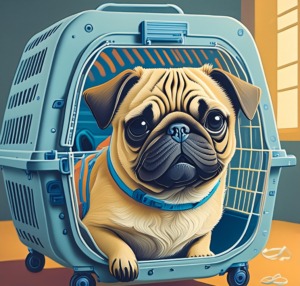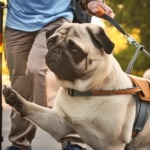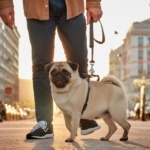Last updated on September 27th, 2024
Here’s an overview:
Understanding Your Pug’s Behavior
Choosing the Right Spot for Potty Training Your Pug
Utilizing Positive Reinforcement for Potty Training Your Pug
Being aware of signs and having a routine will enable
Dealing with Accidents Properly
Using Crate Training Effectively
Addressing Common Potty Training Challenges
How to Ensure Proper Hydration During Potty Training your Pug
The Role of Diet in Potty Training
When To Get Professional Help – And Why?
Understanding Your Pug’s Behavior
potty Training Your Pug is very important; Pugs have certain habits that can affect house training. If you see them sniffing or circling around, they may want to relieve themselves soon. They are intelligent but stubborn animals; thus, one needs patience and consistency.
- Temperament: Usually playful and affectionate but may be stubborn at times too.
- Communication: Often use tail position, ear movements, and other forms of body language to express their needs.
- Habits: Like routine activities which help them predict what comes next in their lives.
- Common Challenges:
- Separation anxiety
- Sensitivity towards harsh discipline
- Socialization: Positive interactions improve adaptability when introducing new schedules.
With this knowledge about their behaviors will enable us train them well.
Creating a Consistent Routine
For successful potty training, it is important to establish an unchanging pattern. Regularity is crucial as far as pugs are concerned because they need something that can help them know when or where relief should be sought.
- Set Regular Feeding Times: The dog should always eat at the same time every day which enables owners predict its time for defecating easily too.
- Scheduled Potty Breaks: Take your pet outside first thing in the morning, after meals, after naps and before bedtime.
- Designated Toilet Area: Take them to the same place always; it will facilitate a quick response.
- Use Commands: For example, you can say “Go potty” so that they associate those words with emptying their bowels or bladder.

Choosing the Right Spot for Potty Training Your Pug
Finding an appropriate potty spot is important in training them effectively. It should always be in the same location all through until they learn that this is where they are supposed to go. The area should also be easily accessible and free from distractions like noise or people traffic.
- Outdoor Spots: Choose quiet areas with few disturbances such as cars passing nearby etc…
- Indoor Spots: Place pee pads at one corner if using them for indoor training purposes only.
- Safety: Make sure there are no toxic substances around where your dog can reach them while being trained indoors or outdoors alike.
- Comfort: Provide a soft surface which will motivate regular use as well.
- Weather: Consider changes in weather patterns when selecting outdoor spots since some may become muddy during rainy days thus discouraging pets from going outside altogether.
Utilizing Positive Reinforcement for Potty Training Your Pug
Positive reinforcement entails rewarding good behavior with treats, praise or playtime among other things. Therefore, owners need to identify what motivates their dogs best during this process.
- Consistent Timing: Give rewards immediately after successful elimination activities done by your furry friend
- High Value Treats: Use specific types of treats which are highly preferred by these animals but reserve them only for use when doing potty training exercises so that they remain effective throughout the period.
- Verbal Praise: Speak kind words filled with happiness each time you comment on how well they did regarding this matter hence making it more likely for future outcomes too because dogs love being appreciated verbally too!
- Consistency: Ensure everybody within the family follows similar rules on how rewards ought to be given out based on good behaviour exhibited by your pet.
- Punishment should not be used in such cases: Concentrate more on awarding positive deeds than punishing accidents that may occur along the way. It is also advisable to keep doing things repeatedly until they form good habits permanently.
- Timing: Knowing When Your Pug Needs to Go
Being aware of signs and having a routine will enable
- Observe: Look out for certain behaviors like sniffing, circling or whining.
- Routine: Make it a habit of taking them outside every morning after meals when waking up from naps before going to bed at night and so forth.
- Consistency: Keep doing this consistently until they get used to it hence knowing what comes next in their lives which is going out there relieve themselves!
- Signals: Watch if they sit near doors for long periods without moving much or stand still instead of walking around; both these actions could mean that they want you open the door let them go pee outside.
- Feed Time: To manage bathroom breaks, feed your Pug at consistent times every day.
Dealing with Accidents Properly
Accidents are bound to happen while potty training. Staying calm is key.
- Never Punish: Do not scold or punish your pug; this will only scare and confuse them.
- Clean Thoroughly: Use cleaners with enzymes in them to get rid of smells and prevent the dog from going again in the same spot.
- Revisit Training: Take the pug to its designated potty area more often so that it can reinforce what it has been taught.
- Observe Behavior: Watch out for signs such as sniffing around or circling which indicate that they need to go, so you can quickly take them outside before they have an accident indoors.
- Routine Adjustments: Have a look at when you are feeding it as well as when you take it out for pee/poop time. If necessary, adjust timings until there is regularity in their routine.
These measured steps help create an environment that promotes positive training behaviour in dogs.
Using Crate Training Effectively
When done right, crate training may be very useful for housebreaking a pug. Consider these points:
- Choose the Right Size: Your crate should be big enough that your Pug can stand up, turn around and lie down comfortably inside it.
- Create a Positive Experience: Make the crate welcoming by putting toys, treats and a soft bed inside where the Pug can see them easily.
- Consistency is Key: Keep regular schedules for meals, crate time and outdoor bathroom breaks. Dogs thrive on routine!

- Monitor Duration: Avoid leaving your pet crated for too long during daytime hours because this could cause discomfort or accidents due to urgent needs being ignored unnecessarily over extended periods of time away from toilets etcetera thus preventing successful toilet training process completion altogether which defeats whole purpose behind using crates properly anyway if done correctly since its main goal is to teach animals where they should go potty when required conveniently within predictable time frames.
Following these steps will make crate training much more effective for potty training your Pug.
Addressing Common Potty Training Challenges
In the process of housebreaking a Pug, there are some issues that owners frequently encounter. These include:
Accidents inside the house:
- Clean with enzymatic cleaners that remove smell completely which might attract them back again thinking it is their toilet area thus preventing repeat offences at same spot over and over again until this problem gets solved once and for all times.
- Establish a consistent schedule for bathroom breaks: Have fixed times during day where you take them out side yard or any other designated place outside home eg balcony etcetera so they can relieve themselves comfortably without having accidents indoors instead due confusion caused by lack of clear instructions provided about what exactly expected from each one involved in process including animal itself
Reluctance to go outside:
Offer high-value treats such as hot dogs, cheese or chicken strips whenever dog does its business outside successfully without any problems encountered along way towards achieving desired results easily understandable even shortest attention spans among us all humans alike since nothing hard understand given fact usually works our favor too because we get good behavior rewards reciprocate accordingly so why not try it yourself today see whether this would be helpful strategy work in your case too?
Create a comfortable potty area with familiar scents:
Use newspapers pads sods other materials used during early stages training process keep them handy same spot next door nearer exit gate access point home entrance etcetera so puppies can identify correct location their needs relieve themselves when necessary without getting confused about where exactly supposed do business.
- Crates: A crate can create a controlled environment that is conducive to potty training.
- Training Spray: Attracts a dog to a specific potty area.
- Stain and Odor Removers: Necessary for cleaning up after accidents and preventing repeat marking.
- Positive Reinforcement Treats: Rewards given to encourage good behavior.
- Puppy Gates: Used to block off access to certain areas.
- Pooper Scoop Bags: For easy clean-up when outside.
How to Ensure Proper Hydration During Potty Training your Pug
Proper hydration is very important during training sessions with your Pug. Here are some recommendations:
- Accessible Water: Make sure fresh water is always available
- Water Quality: Use clean, filtered water to avoid contaminants
- Regular Breaks: Take frequent water breaks, especially in hot weather
- Monitor Intake: Keep track of how much your Pug drinks
- Signs of Dehydration: Look out for dry gums or lethargy which could indicate dehydration
- Portable Bowls: Bring travel-friendly water bowls for outdoor training sessions
- Hydrating Foods: Give treats with high moisture content alongside regular meals
Good hydration helps focus and overall health during training.
The Role of Diet in Potty Training
Diet plays a major role in successful potty training for pugs. It’s important to feed them at consistent times so they develop predictable bathroom habits. Providing dogs with high-quality food that meets their nutritional needs will promote healthy digestion and reduce the chances of irregular bowel movements.
- Choose premium dog food formulated specifically for pugs’ dietary requirements.
- Avoid feeding table scraps or human food as it may upset their stomachs.
- Keep fresh water available all day which encourages frequent urination.
“Feeding them at the same time every day sets expectations,” says vets.

Implementing a designated meal schedule can help pet owners identify when their furry friend needs to relieve themselves, thus making housebreaking more effective.
When To Get Professional Help – And Why?
For some owners, potty training their pug can be an especially difficult task. Here are some signs that professional assistance might be needed:
- Consistent accidents: If your pug continues having accidents even after being trained consistently
- Behavioral problems: When the dog exhibits extreme fear or aggression toward any aspect of elimination
- Medical concerns: If there is reason to believe that physical health issues may affect bladder control or ability to hold urine
- Lack of progress: If no noticeable improvements have been made over prolonged periods despite trying different methods and approaches
- Expert advice: To get one-on-one guidance from experts who specialize in working with dogs like yours
Article from: Abdullah (Senior Trainor)




